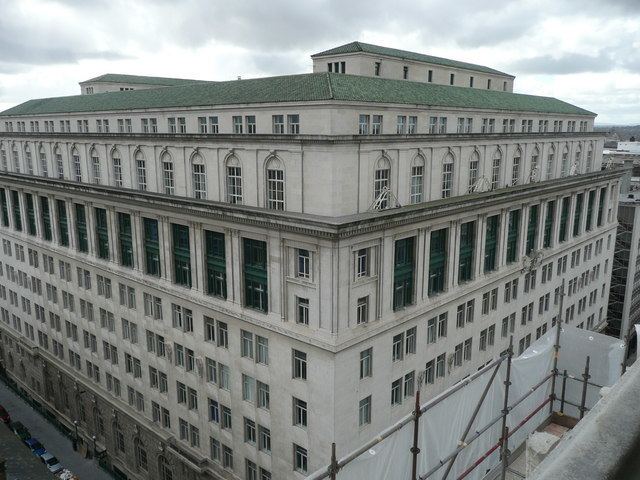OS grid reference SJ 341 904 | Built 1924–32 | |
 | ||
Architectural style(s) Italian Renaissance with American Beaux-Arts features | ||
India Buildings is a commercial building with its principal entrance in Water Street, Liverpool, Merseyside, England. Mainly an office building, it also contains an internal shopping arcade and the entrance to an underground station. It was built between 1924 and 1932, damaged by a bomb in 1941, and later restored to its original condition under the supervision of one of its original architects. The building, its design influenced by the Italian Renaissance and incorporating features of the American Beaux-Arts style, occupies an entire block in the city.
Contents
History
India Buildings was built between 1924 and 1932. The competition for its design was won in 1923 by Arnold Thornely and Herbert J. Rowse, the assessor being Giles Gilbert Scott. It was built as a speculative venture by the shipping firm of Richard Durning Holt and Alfred Holt and Company (the Blue Funnel Line) partly for its own use, and partly for letting offices to other businesses. It was built by Dove Brothers of Islington, its steelwork being made and erected by Dorman Long of Middlesbrough. The cost of the building was £1.25 million (equivalent to £78,260,000 in 2015). The building replaced an older one on the site known as "India Building", built in the 1830s for George Holt, the father of Alfred. The new building was constructed in two stages, the first stage being alongside the earlier building, and the second stage demolishing and replacing it. The two stages straddled the former Chorley Street. Before the design was approved, Liverpool Corporation stipulated that an arcade of shops should run through the centre of the building on the route of the street, and this was incorporated into the design. The original occupants included Lloyds Bank, a Post Office, commercial and insurance companies, solicitors, and government offices. Alfred Holt and Company occupied most of the sixth, seventh and eighth floors. Also in the building were a public hall and a constitutional club. India Buildings was badly damaged by bombing in 1941, and was later restored to its original condition under the supervision of Herbert J. Rowse.
The property became involved in one of the UK's largest fraud cases when it was used as collateral for large loans made by a company operated by Achilleas Kallakis and Alexander Williams. They had arranged for loans to be made in excess of the value of the buildings. This money was used to finance an expensive lifestyle including a helicopter and a plane.
India buildings was sold to an Irish company called Green Property in 2009 who still owned it in January 2013 when the former owners, Kallakis and Williams were jailed for fraud.
Exterior
The building occupies a whole block, and is surrounded by Water Street, Brunswick Street, Fenwick Street, and Drury Lane. It has nine storeys, a mezzanine, a basement and a sub-basement. The building is constructed on a steel frame and is clad in Portland stone. It is roofed in green Lombardic tiles. The main entrance is on Water Street, this front having 13 bays. The entrance itself consists of three tall arches that are flanked by four bronze lamps, made by the Bromsgrove Guild, their design being based on those at the Palazzo Strozzi in Florence. Over the entrance is an ornamental balcony. At the basement level are four decorative shop fronts, and to the right of these is an entrance to the James Street underground station. The Brunswick Street front is similar, except that its entrance has one arch rather than three. The Fenwick Street front and the Drury Lane front have 15 and 14 bays respectively.
Sculpture
All the sculpture on the exterior of the building is by Edward C. Thompson. The keystones in the arches over the doorways and above some of the windows are carved with cherubs. Rather than all being identical, their designs are slightly varied. A frieze runs around the building just below the level of the top floor windows. On both the Water Street and the Brunswick Street fronts and incorporated in the frieze are crests, each of which is carved with a figure of Neptune kneeling in a scallop shell, and two reclining Tritons, reflecting the building's maritime connections.
Interior
A shopping arcade runs through the centre of the building, with offices on all floors. The entrances in Water Street and Brunswick Street lead into foyers. Each foyer has three painted and coffered saucer domes in the ceiling, supported by fluted Ionic columns in Travertine marble. There are doors to two lifts on each side. The shopping arcade has Travertine walls and floors, and a coffered barrel-vaulted ceiling with pendant lights. Along the sides of the arcade are shops with decorative bronze fronts. Elsewhere on the ground floor are larger areas originally occupied by the bank, the Post Office and the public hall. The upper floors contain offices, some of which have retained their original layout, while others have been altered.
Appraisal
India Buildings was designated as a Grade II listed building on 14 March 1975. Following a campaign by the Twentieth Century Society, its designation was raised to Grade II* on 5 November 2013. One of the reasons given for this elevation in status is its transatlantic influence, reflecting Liverpool's historic links with the United States, stating that it "emulates the most impressive early 20th-century commercial buildings of the US", particularly those in New York. Other reasons include its architectural interest, including influences from the Italian Renaissance and the American Beaux-Arts movement, and the eminence of its architects. Also noted are its planning interest, in that it follows the United States grid system of town planning, the high quality of its internal finishes, its degree of survival with its major elements having been retained, and its group value with the nearby listed buildings.
